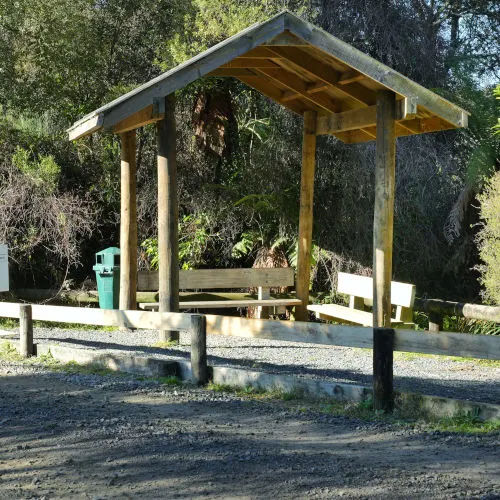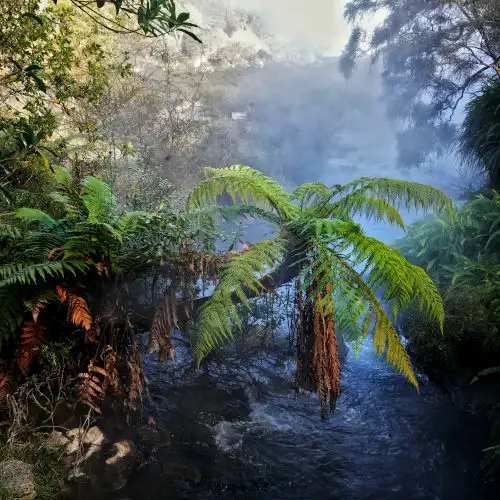
On the second day of our Rotorua trip, we embarked on a morning journey to the Waimangu Volcanic Valley. Since my in-laws had made all the arrangements, I simply enjoyed the relaxing half-hour drive from Pullman Hotel in Rotorua.
I wasn't sure what to expect, with only a mental image of a volcanic mountain and crater based on its name. I later realized I would explore the world's youngest geothermal valley, encountering geothermal activity, hot springs, and volcanic craters.
We arrived at the Waimangu Volcanic Valley and parked at the spacious parking area in front of the visitor’s center. Since it was not peak holiday season, we found ourselves among only a few parked cars. The serene atmosphere promised an exciting day ahead, but little did I know what surprises awaited us until we entered this volcanic wonderland.
Watch the video we shot at Waimangu Volcanic Valley (at the end of this article) 👇👇.
Exploring Waimangu Volcanic Valley: Visitor Center and Tour Options
The visitor center has a gift shop, washrooms, and a reception area. Since we had already purchased our tickets online, the receptionist quickly provided essential information for our visit.

Following their advice, we used the center's restroom facilities before commencing our journey, as there would be only two toilet stops throughout the visit.

We opt for the full Waimangu experience, including walking through various hot springs, native forests, native bush, and geysers, then joining the Lake Rotomahana boat cruise.
The tour is divided into two parts. The first part involved a self-guided 1.5 hours walking tour, leading from the visitor center to the jetty of Lake Rotomahana. In the second part, we took a 45 minutes guided boat tour of the lake. While we could explore at our own pace during the walk, we needed to arrive at the jetty by 11.00 am as the boat would depart on time.
Note:
- For those who do not want to take the full walk, a convenient shuttle bus service was available, ensuring everyone could experience the wonders of Waimangu Volcanic Valley, regardless of their preferred mode of transportation.
- Don't forget to collect the map guides from the reception at the visitor's center. These guides offer invaluable information detailing the precise locations of each viewing point throughout the journey.

Unexpected low visibility during the walk
Armed with a guide sheet highlighting all the scenic viewpoints, we set out eagerly to explore everything the Waimangu Volcanic Valley had to offer.

However, our excitement was dampened by heavy fog and steam emanating from the volcanic ground, obscuring our view completely.
While at the Echo Crater, we couldn't see anything due to the thick smoke.
We hoped the visibility would improve, but the thick fog persisted, making many of our photos and videos unusable. Despite the undesirable visibility, we decided to make the most of the moment and capture as many photos as possible. Among them, we managed to salvage a few remarkable shots that captured the essence of our extraordinary adventure.
We snap a decent photo of the Emerald Pool. However, the impressive sight of the Frying Pan Lake (the world’s largest hot spring) remained obscured by thick smoke, leaving us yearning for a clearer view.

Continuing our trek, we encountered the Crystal Wall, which surprised us with its intense heat when we touched it.

Next, we arrived at the Cathedral Rocks and Waimangu Geyser, the magnificent sights among the valley's geological marvels.

At approximately 50°C, the Hot Water Creek and Springs gush forth from the Frying Pan Lake, showcasing a remarkable fusion of minerals and blue-green algae that gives rise to its breathtaking and vibrant colors.


The silica-rich waters of this boiling spring form an unusual shell-shaped terrace and help to maintain the adjacent stream temperature.









The visibility improved as we moved forward. Our camera clicked away, capturing more striking images of the remarkable places along our trek through this breathtaking landscape.


Lake Rotomahana cruise: A picturesque journey
Underneath a serene blue sky, we reached the jetty of the beautiful Lake Rotomahana at the end of the walk, just ten minutes before the cruise's departure.


With such favorable weather, we anticipated a magnificent view during the cruise, offering ideal conditions for photography.


As the cruise set off from the jetty, we crossed Patiti Island, a rocky formation dating back approximately 18,000 years, similar to the oldest part of the Tarawera volcano. Before the 1886 volcanic eruption, it appeared as a small hill. During that eruption, it transformed into the remnant of a lava plug or dome that had solidified after extrusion. The 1886 eruption drastically changed its appearance, removing much of it and revealing the original solid lava core.

During the cruise, our knowledgeable captain regaled us with fascinating historical tales about the lake, the renowned Pink and White Terraces, and the stories of the Mt Tarawera eruption, which resulting dramatic landscape changes. His onboard commentary provides valuable insights, making our journey more engaging and enriching.
The cruise continued, sailing towards the far end of the lake, where the stunning Tharawera Chasm awaited us. The captivating landscapes and geological wonders provide endless photography opportunities and cherish Lake Rotomahana's beauty.
A spectacular encounter: Lake Rotomahana's Steaming Cliffs
The highlight of our cruise was witnessing the geysers. Our cruise approached the steaming cliff, where an impressive display of hot water, geysers, and steaming vents adorned the steep southwest side of the lake. Known collectively as the Steaming Cliffs, these remarkable features are the surface expression of the geothermal system that has been active since well before the 1886 eruption. We were fortunate to witness geysers playing onshore, not far from the lake's edge.





After watching the magnificent display of geysers and steaming vents, our cruise smoothly returned to the jetty. However, we did not need to retrace our steps, as we took the bus service for our return journey to the Waimangu visitor center.

This half-day geothermal experience completely immerses us in the unique environment of Waimangu Volcanic Valley.
Waimangu Geothermal Valley- a brief introduction
The geothermal features at Waimangu are the only geothermal system created within written history. It is the world’s youngest geothermal system.

Therefore its creation can be pin-pointed to an exact time and event - the Mount Tarawera Eruption of 10 June 1886. Everything we see at Waimangu is a direct result of the 1886 eruption.
There is a huge amount of volcanic energy driving the geothermal system. This energy comes from a large magma chamber approximately 2km below the valley. The magma superheats the geothermal aquifer (fluids trapped within the earth). Fluid from the aquifer finds its way to the surface along dykes (cracks and fissures) formed during the eruption in 1886. Frying Pan Lake is the largest hot water spring in the world by surface area and the second largest by discharge.
Inferno Crater Lake is a huge geyser-like hot water spring (Crypto Geyser). There is an unexplained link between Frying Pan Lake and Inferno Crater. The discharges of each spring vary inversely to each other. Magnificent sinter terraces and delicate stalactites form from minerals solidifying out of the geothermal fluids.
Note: Waimangu, which means 'Black Water,' derives its name from the geyser's tendency to eject black sand, mud, and rocks into the air.
Watch the video we shot at Waimangu Volcanic Valley 👇👇.
We also upload a video we shot at Waimangu Volcanic Valley. Please click the image below to bring you to our YouTube channel (shot in high definition!). You may also want to check out our visit to Blue Spring Putaruru and Aratittia Dam.

